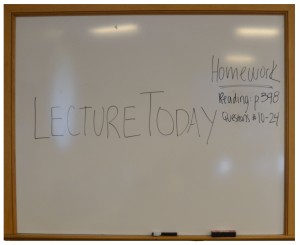
There is a new concept buzzing throughout the academic community as the flipped classroom becomes more and more popular, especially in science and math classes.
The flipped classroom inverts traditional teaching methods, delivering some type of online lecture to students at home, while moving “homework” and more hands-on problem solving into the classroom. The idea stemmed from the belief that “one size does not fit all,” and students learn in different ways. So far, Math Department Head Diana Kaplan, Biology teacher Tessa Johnson, and Science Department Head Bill McLay, have predominantly used the flipped classroom concept, which they learned about from seventh and eighth grade science teacher Daniel Lipin.
Mr. Lipin records four to six minute videos and posts them for students using Google Drive and Google sites. His students then spend about 50 % of homework assignments watching these videos and taking notes. In class, students do activities and labs to cement their understanding of the video content and also expand on it. According to Mr. Lipin, the flipped classroom has been beneficial because classes are a lot more engaging without lectures and students can learn at home at their own pace.
Ms. Johnson learned about the inverted classroom from an AP Biology conference last summer and she has since integrated the system into her own AP Biology class. She noted that the textbook can be very intimidating sometimes, so she used lectures in conjunction with textbook reading to make the information more reachable for students.
“You’re engaging all of your senses in doing this type of homework,” said Ms. Johnson, “When you are listening to a lecture, you listen and see, so you engage more of your brain in the process.” Students agree that they learn more by actively watching videos and taking notes on material introduced by different speakers.
Flipped classrooms allow students to learn complex materials in different ways and are a nice variation in learning style. Since many students learn in different ways, the flipped classroom allows students to learn the material in the time frame they need and to ask questions in class the following day. Flipped classrooms are also very beneficial in science classes because they allow for more lab time.
A study done by teachers at Clintondale High School, just north of Detroit, Michigan, showed an example of the flipped classrooms’ positive impact on graduation rates. After more than half of the senior class wasn’t graduating, educators split the grade into half flipped classrooms and half normal classrooms, and the graduation rate actually increased in the inverted classroom sections. The flipped classroom provides teachers with a chance to enhance certain lessons and intrigue students, but this system should only be used sparingly because students could lose interaction time with teachers during class.

“I would never want to go to a system where all I did was have students listen to lectures at home because then students cannot ask questions and we cannot have a dynamic conversation. In class, people ask questions I had never even thought about, and you miss that piece when you invert the classroom,” said Ms. Kaplan.
This system is also very time consuming for teachers. Teachers must first discern what lessons are actually applicable to the flipped classroom. They then must take the time to record lectures and videos, and create activities and challenges for the students to test their understanding of the material during class. Overall, the flipped classroom system can be extremely beneficial, but it is not sustainable for long periods of time because students will miss out on face-to-face time with their teachers.
Senior Laurel Cassidy said, “I liked inverted classrooms but it’s not something I would want to do for every lesson. While it is a cool, unique way to learn and is definitely helpful with homework, I also enjoy a normal classroom setting because it’s more interactive.”


